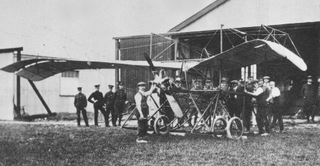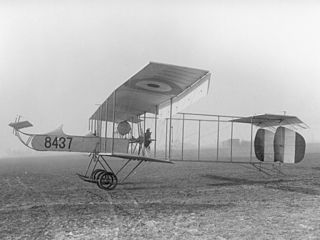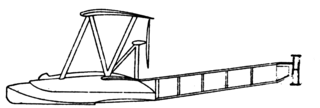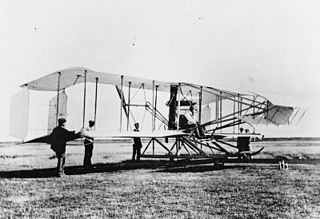Related Research Articles

The Vickers F.B.5 was a British two-seat pusher military biplane of the First World War. Armed with a single .303 in (7.7 mm) Lewis gun operated by the observer in the front of the nacelle, it was the first aircraft purpose-built for air-to-air combat to see service, making it the world's first operational fighter aircraft.

The Boxkite was the first aircraft produced by the British and Colonial Aeroplane Company. A pusher biplane based on the successful Farman III, it was one of the first aircraft types to be built in quantity. As the type was used by Bristol for instruction purposes at their flying schools at Larkhill and Brooklands many early British aviators learned to fly in a Boxkite. Four were purchased in 1911 by the War Office and examples were sold to Russia and Australia. It continued to be used for training purposes until after the outbreak of the First World War.

The Short S.14 Sarafand was a British biplane flying boat built by Short Brothers. It was planned as a general reconnaissance aircraft for military service. When it was built in 1932 it was the largest aeroplane in the United Kingdom.
The Bristol Biplane Type 'T', sometimes called the Challenger-Dickson Biplane, was a derivative of the Bristol Boxkite. It was built in 1911 by the British and Colonial Aeroplane Company and was designed as a cross-country racing aircraft for Maurice Tabuteau.
The Pemberton-Billing P.B.25 was a First World War British single-seat scout aircraft built by Pemberton-Billing Limited, later Supermarine Aviation Works Limited.

The Bristol Gordon England biplanes were a series of early British military biplane aircraft designed by Gordon England for the Bristol Aeroplane Company that first flew in 1912. Designed for easy ground transport, the aircraft could be quickly disassembled.

The Blackburn Triplane was a single-engine pusher single-seater, designed specifically to attack Zeppelins. It flew in 1917, but was not successful.
The Short No.2 was an early British aircraft built by Short Brothers for J.T.C. Moore-Brabazon. It was used by him to win the £1,000 prize offered by the Daily Mail newspaper for the first closed-circuit flight of over a mile (1.6 km) to be made in a British aircraft.

The Short S.41 was a British single-engined biplane built for the Royal Navy in 1912. Capable of being operated either on wheels or floats, it was successful enough for a further two similar aircraft to be built, with the type remaining in use until the early years of the First World War.

The Dunne D.8 of 1912 was a tailless swept wing biplane, designed by J. W. Dunne to have inherent stability. One example was supplied to RAE Farnborough. License-built Burgess-Dunne models were used by the US Signal Corps and United States Navy and the short-lived Canadian Aviation Corps. It was the latter's first and only warplane.

The Dunne D.7 was one of J. W. Dunne's swept wing tailless aircraft designed to have automatic stability, first flying in 1911. It was a single seat, single engined pusher monoplane developed from the unsuccessful D.6.

The Short S.27 and its derivative, the Short Improved S.27, were a series of early British aircraft built by Short Brothers. They were used by the Admiralty and Naval Wing of the Royal Flying Corps for training the Royal Navy's first pilots as well as for early naval aviation experiments. An Improved S.27 was used by C.R. Samson to make the first successful take-off from a moving ship on 9 May 1912.

The Short S.38 was an early British aircraft built by Short Brothers.

The Zeppelin-Lindau Rs.II was a biplane flying boat, designed by Claudius Dornier and built during 1914-15 on the German side of Lake Constance. Initially this aircraft was powered by three engines mounted inside the hull driving three pusher propellers via gearboxes and shafts. The later version was powered by four engines in two push-pull nacelles mounted between the wings.
The Graham-White Type VII "Popular" was an early British aircraft designed by J. D. North and built by the Grahame-White Aviation company, with the intention of producing a low-cost aircraft to popularize aviation. It was initially produced with a 35 hp Anzani 3-cylinder Y configuration engine and offered for sale at a price of less than £400. Despite its low price the aircraft included structural refinements such as hollow-section interplane struts. It was first flown in 1913.

The Short No.1 biplane was an early British aircraft built in 1909 by Short Brothers. Although it never flew, it was notable for being the first aircraft designed by Horace Short.

The Short S.36 was a British two-seat tractor biplane, built by Short Brothers for Francis McClean in 1911. It was later developed into the Short S.41 and Short S.45, which were the first of a long series of similar aircraft built for the RNAS and RFC.
The Short S.47 Triple Tractor was one of a series of experimental twin-engined aircraft built by Short Brothers in 1912. It acquired its name because the two engines drove three tractor propellers.
The Voisin Type Bordeaux was an aircraft built by Voisin Frères in 1910, so-called because it was used by Juan Bielovucic to make a record-breaking flight from Paris to Bordeaux. The design differed significantly from previous Voisin designs in eliminating the forward-mounted elevator.
The Caudron Type H was a collective name for three different Caudron designs of 1912-3. One of these was an amphibious three seat biplane built for the French military. Two were completed, one appearing at the Paris Aero Salon in November 1912.
References
- Barnes, C.H. Shorts Aircraft Since 1900. London: Putnam, 1967.
- Lewis, P. British Aircraft 1809–1914 London: Putnam, 1962
- BBC News Magazine 5 January 2014: The three-month flight along the Nile